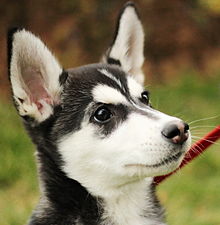Designer dogs
The Encyclopædia Britannica traces what was the "designer dog" fad to the late 20th century, when breeders began to cross purebred Poodles with other purebred breeds in order to obtain a dog with the Poodle's hypoallergenic coat, along with various desirable characteristics from other breeds.[4]
The primary identifying mark of a designer dog is that the resulting puppies are called by a portmanteau word made up of syllables (or sounds) from the breed names of the two purebred parents, such as Schnoodle (Schnauzer and Poodle cross).[4] or Shepsky (German Shepherd Dog/Siberian Husky cross). Other purebred breeds are being crossed to provide designer dogs described with an endless range of created labels, such as the Puggle (Pug and Beagle cross). There are even complex crosses (with multiple breeds in recent ancestry) being labeled in this manner, such as German Chusky (German Shepherd Dog, Siberian Husky and Chow Chow cross).
Like children in a family, a percentage of designer dogs with the same breed ancestry will look similar to each other, even though crossbreeding does not result in as uniform a phenotype as the breeding of purebreds. Often even pups in the same litter will look quite different.
Another defining characteristic of designer dogs is that they are usually bred as companion dogs and pets. Working and hunting dogs deliberately crossbred for a particular working purpose are not generally given portmanteau names; they are most often referred to by a type name, such as Eurohounds (racing sled dogs) or lurchers (hunting dogs). These dogs could be considered only as crossbreeds, not as designer animals, since appearance is not the main reason for them to be bred. An exception to this is the Labradoodle, which although having a portmanteau name, is often used as a Guide or Assistance dog[5][6] as well as being a popular family dog.
Although designer dogs are often selected by owners for their novelty, reputable breeders sometimes use crossbreeding in an attempt to reduce the incidence of certain hereditary problems found in the purebred dogs, while retaining their more appealing traits. Jon Mooallem, writing in The New York Times, commented, "Given the roughly 350 inherited disorders littering the dog genome, crossing two purebreds and expanding their gene pools can be 'a phenomenally good idea,' according to one canine geneticist—if it is done conscientiously."[7] Crossbreeding has not been well studied in dogs, although it has been for livestock. The heritability of the desired trait being bred for (such as a hypoallergenic coat) needs to be known; "Heritability is the proportion of the measurable difference observed between animals for a given trait that is due to genetics (and can be passed to the next generation)."[8] In addition, the goals of dog crossbreeding may be harder to define than the goals of livestock crossbreeding; good temperament may be harder to define and measure than high calf weight.[citation needed]
Designer dog breeders are often criticised for being more interested in profitable puppy production than in dog health and welfare. Wally Conron, writing in Reader's Digest, comments on the popularity of crosses after his introduction of the Labradoodle: "Were breeders bothering to check their sires and bitches for heredity faults, or were they simply caught up in delivering to hungry customers the next status symbol?"[9]
'Designer dog' puppies sometimes bring higher prices than the purebreds from which they are bred.[ Fanciers of designer dogs say that all modern dog breeds were created from earlier breeds and types of dogs through the same kind of selective breeding that is used to create designer dogs. The Toy Poodle was bred down in size from the larger Standard Poodle, most likely by crossing with various very small Bichon types, such as the Maltese and Havanese.[14] Most of the modern breeds have ancestries that include various older dog types and breeds; see individual breed articles for details of the origin of each breed.
Health of crossbred dogs depends on their being descended from healthy parents. Breeders who select their breeding stock for cost-effectiveness and who skip health testing for the same reason will not produce puppies that are as reliably healthy as those bred by more conscientious breeders. However, studies of longevity in dogs have found some advantage for crossbreeds compared to purebred dogs.[15] In general it is believed that crossbred dogs "have a far lower chance of exhibiting the disorders that are common with the parental breeds. Their genetic health will be substantially higher.



